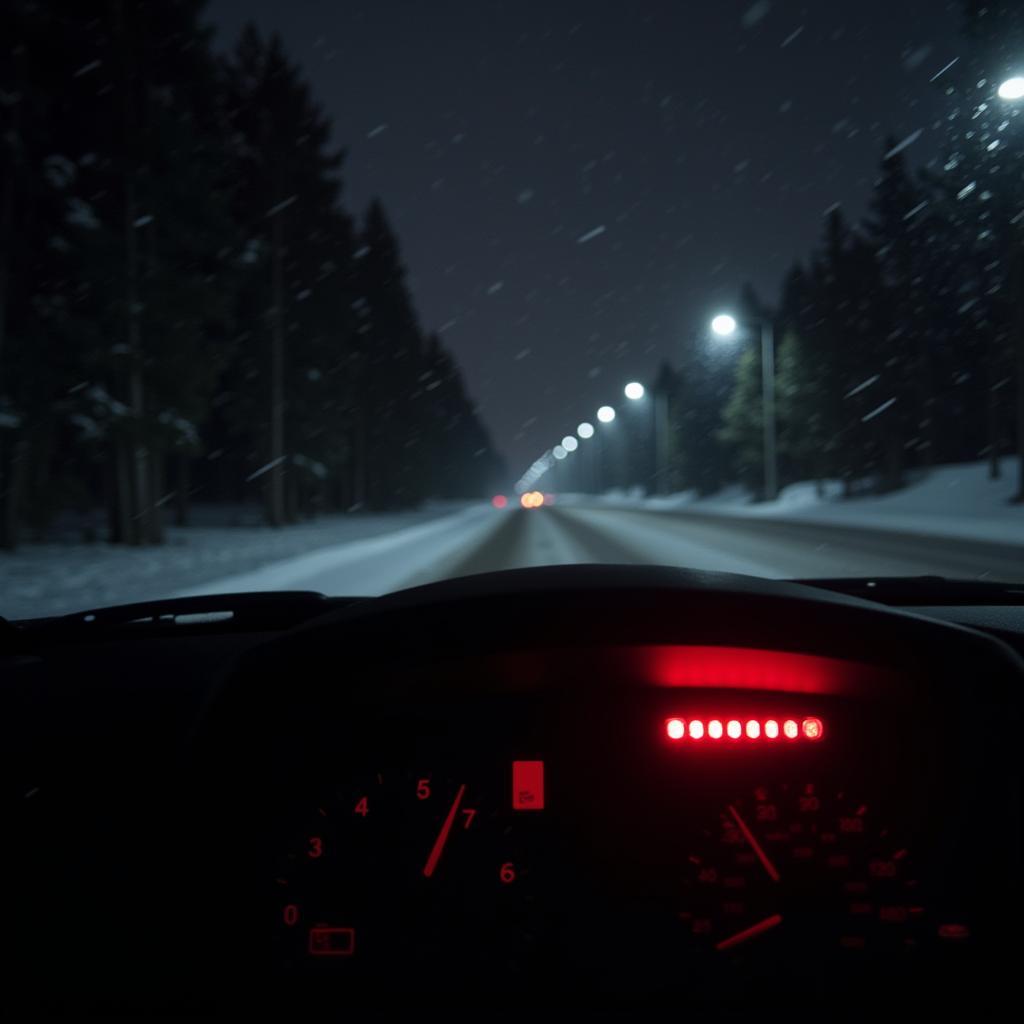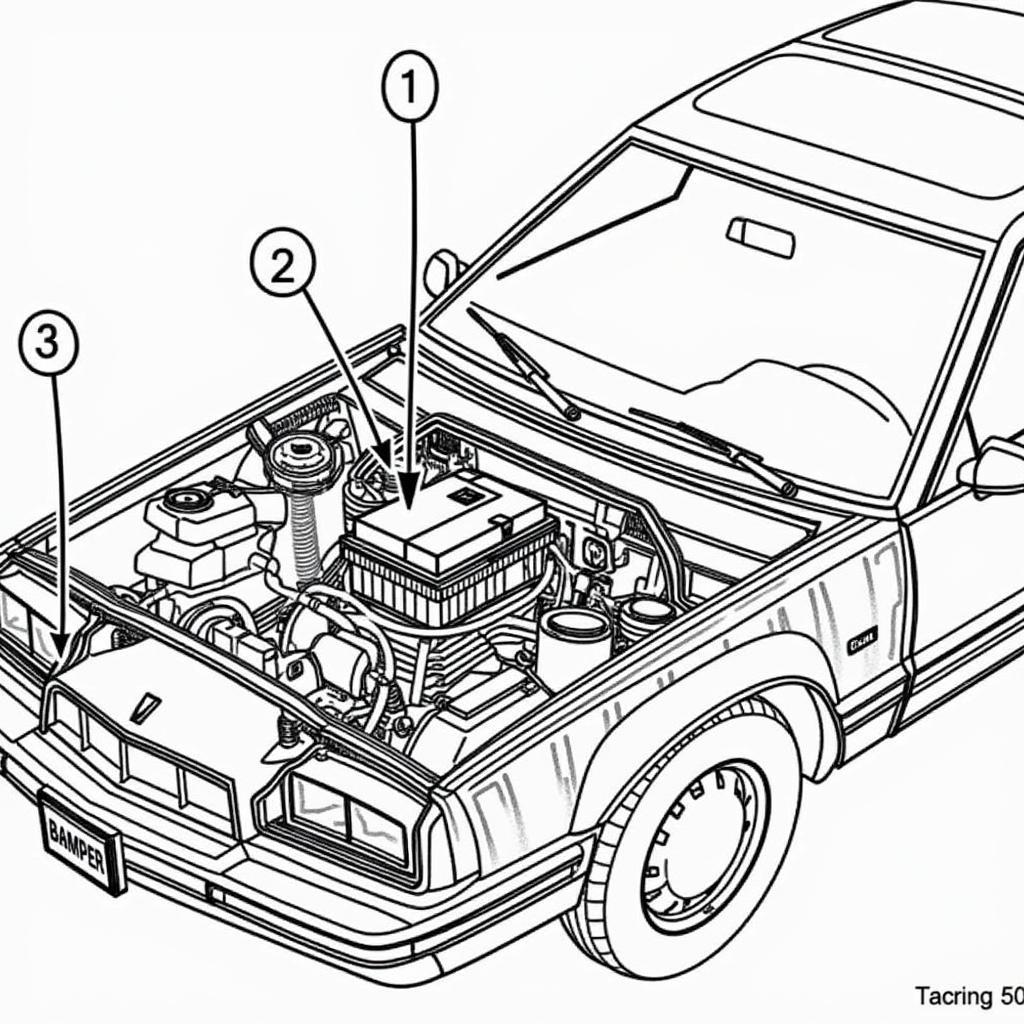You’re driving to work on a frigid winter morning, and suddenly, you see it – the dreaded brake warning light glowing on your dashboard. It’s enough to send a shiver down your spine, and not just because of the cold. But don’t panic just yet! While a brake warning light should never be ignored, it doesn’t always signify a critical issue, especially in cold weather.
 Car dashboard with brake warning light illuminated in snowy conditions
Car dashboard with brake warning light illuminated in snowy conditions
Why Does My Brake Warning Light Come On in Cold Weather?
There are several reasons why your brake warning light might illuminate during a cold snap, some more serious than others. Let’s break down the common culprits:
1. Brake Fluid Issues: The Usual Suspect
Brake fluid plays a vital role in your car’s braking system. When you press the brake pedal, the fluid amplifies the force, pushing the brake pads against the rotors and stopping your vehicle. However, brake fluid is hygroscopic, meaning it absorbs moisture over time. This absorbed moisture can freeze in cold temperatures, forming ice crystals within the brake lines. These ice crystals can obstruct the flow of brake fluid, hindering its ability to transmit pressure effectively and triggering the warning light.
 Close-up of frozen brake lines on a car
Close-up of frozen brake lines on a car
Expert Insight: “One of the most common reasons we see brake warning lights in winter is due to moisture-contaminated brake fluid. It’s crucial to have your brake fluid flushed and replaced regularly, especially as recommended in your car’s owner’s manual.” – Mark Stevenson, Senior Automotive Technician
2. Low Brake Fluid Level: A Gradual Concern
Similar to the issue of contaminated fluid, a low brake fluid level can also trigger the warning light, especially in colder temperatures. As brake pads wear down over time, the brake fluid level naturally drops. In cold weather, this slight drop in fluid level can be enough to trigger the sensor, illuminating the warning light.
Expert Insight: “If your brake warning light comes on and you’ve recently had your brake pads replaced, it’s likely a simple case of low brake fluid. A quick top-up should do the trick, but it’s always best to have it checked by a professional.” – Maria Sanchez, Certified Master Technician
3. Faulty Brake Light Switch: An Unlikely Culprit
While less common, a faulty brake light switch can also be the reason behind your brake warning light illuminating, regardless of the weather. The brake light switch activates your brake lights when you press the pedal. If this switch malfunctions, it can disrupt the signal to the brake lights and, in some cars, also trigger the brake warning light.
 A car brake light switch held in a hand
A car brake light switch held in a hand
4. Worn Brake Pads: A Gradual Warning
Worn brake pads can also trigger the brake warning light. Most cars have wear sensors on the brake pads that activate when the pads reach a certain level of wear. This is a helpful reminder to get your brake pads replaced before they cause further damage to the rotors.
What Should I Do if My Brake Warning Light Comes On in Cold Weather?
If your brake warning light comes on in cold weather, the first and most crucial step is not to panic. Here’s what you should do:
- Assess Your Brakes: Carefully pay attention to how your brakes feel. Are they spongy? Do you need to press the pedal further down than usual? Any change in brake feel warrants immediate attention.
- Find a Safe Spot: If possible, pull over to a safe location as soon as possible. Avoid driving further than absolutely necessary with an illuminated brake warning light.
- Check Your Brake Fluid: If it’s safe to do so, pop the hood and check your brake fluid level. If the fluid level is low, add more brake fluid (make sure it’s the correct type for your car).
- Seek Professional Help: Whether you’re able to add brake fluid or not, it’s essential to get your car to a qualified mechanic as soon as possible. They can diagnose the problem accurately and make the necessary repairs.
How Can I Prevent Brake Issues in Cold Weather?
Here are some proactive steps to minimize the chances of encountering brake issues during winter:
- Regular Brake Fluid Flush: Follow the manufacturer’s recommendations for brake fluid flushes, typically every 2 years or 24,000 miles.
- Check Brake Fluid Regularly: Get into the habit of checking your brake fluid level monthly, especially during winter.
- Inspect Your Brakes: Regularly inspect your brakes for signs of wear and tear, including worn pads, leaks, or damaged lines.
- Address Issues Promptly: Don’t ignore any unusual noises, vibrations, or changes in brake pedal feel. Have them inspected by a professional promptly.
FAQs:
1. Can cold weather damage my car battery and cause a brake warning light?
While a weak battery can cause various electrical issues, it’s unlikely to directly trigger the brake warning light. However, a low car battery can affect other systems that might indirectly impact your brakes.
2. My Ford Escape 2010 brake warning light comes on in cold weather. What could it be?
Ford Escapes, like many vehicles, can experience brake fluid issues in cold weather. However, it’s crucial to have it diagnosed by a mechanic familiar with Ford vehicles to rule out any model-specific concerns.
3. All my brake warning lights are on. What should I do?
If all your brake warning lights are illuminated, it indicates a serious issue. Pull over immediately and have your car towed to a mechanic.
4. What do the different brake warning lights mean?
Different brake warning lights indicate different issues. A red (!) symbol usually signals a problem with the parking brake, while a circled (!) symbol often relates to the ABS system.
5. My Seat Leon has dash warning lights, including the brake warning light. What could be wrong?
Similar to other vehicles, a brake warning light on a Seat Leon might be due to cold weather affecting the brake fluid. However, multiple warning lights suggest a potential electrical or sensor issue that needs professional diagnosis.
Don’t Ignore the Warning
A brake warning light in cold weather shouldn’t be taken lightly. While it might be a minor issue like low brake fluid, it could also indicate a more serious problem. By taking proactive steps to maintain your braking system and addressing any issues promptly, you can ensure safe and worry-free driving throughout the winter months.

